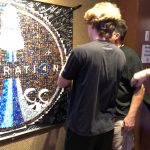(Oct. 7, 2021) After spending the past year shuttling SpaceX Inspiration4 crew members around the country for astronaut training, Ocean Pines resident Kurt Zender, a corporate pilot employed by billionaire space-flight sponsor Jared Isaacman, relived childhood memories of Cape Canaveral rocket launches when he attended liftoff for the first all-civilian orbital mission last month.
Isaacman chartered the SpaceX flight, which blasted skyward from the Kennedy Space Center on Sept. 15, to raise money for St. Jude Children’s Research Hospital in Memphis, Tennessee.
Selected to accompany Isaacman were Hayley Arcenaux, a physician assistant at St. Jude’s and childhood bone-cancer survivor, Chris Sembroski, an aerospace data engineer, and geoscientist Sian Proctor.
Following an initial donation of $100 million by Isaacman, the three-day space flight that reached altitudes topping 360 miles, has to this point raised roughly $160 million for the world-renowned cancer institute.
Zender, a 30-year aviation veteran who began flying for Isaacman in 2009, was inspired to shoot for the sky by his father, Frank, who worked for NASA and took him to witness Space Shuttle sendoffs at Kennedy Space Center.
“He was contracted from RCA to NASA and ran tracking stations,” he said.
When not traveling on assignments at NASA tracking stations along coastlines in the Atlantic and Pacific, Frank Zender would occasionally bring his son to Cape Canaveral.
“All my friend’s fathers worked for NASA,” he said. “As a kid, I remember looking at that shuttle runway and thinking I wanted to be able to take off.”
Zender and his family relocated from Atlanta, Georgia to Ocean Pines in 2008. The following year, he was hired by Isaacman’s flight charter company, 26 North Aviation, to train pilots on the newly leased Gulfstream G100 twin-engine business jet.
“When I first met him, we were going to fly, just the two of us,” he said.
Isaacman, also a seasoned pilot with thousands of air hours, invited Zender to hop onboard a Russian fighter-trainer jet without disclosing the pair was part of a larger death-defying public display.
“It turned out it wasn’t just us, it was an airshow team,” he said.
Isaacman is CEO of Shift4 Payments, a payment-processing company handling $200 billion annually with $300 million in revenues, which was started in 1999 as United Bank Card.
In 2012, Isaacman co-founded Draken International to train U.S. military pilots. Headquartered in Florida, Draken’s fleet of fighter jets is among the largest privately owned collections worldwide.
During the past decade, Zender has globetrotted repeatedly while flying Isaacman to points far and wide, including a mountaineering expedition in Antarctica.
“You’re literally landing on a glacier and it moves 60 meters a year,” he said. “Every year we have to get new coordinates for the end of the runway.”
Zender said Isaacman hatched plans for the recently completed civilian mission during a phone call with SpaceX on an unrelated topic over a year ago.
“He was on a call with SpaceX … and he just mentioned, ‘Hey, if you guys ever want to send a civilian crew in, I’m on board,’” he said. “They said, ‘You know, we are thinking about that.’”
In 2002, Tesla automaker Elon Musk founded aerospace manufacturer Space Exploration Technologies [SpaceX] to minimize space travel costs in hopes of colonizing Mars.
The recent SpaceX civilian-flight plans were kept under wraps until they were revealed in a Super Bowl commercial in February.
“It was pretty tight-lipped,” he said. “I didn’t know.”
Once word was out, Zender was quickly enlisted to help during months-long pre-flight preparations.
“We were basically running the astronauts around to all the different facilities to train,” he said. “They trained just like the astronauts did in the sixties.”
Zender said the four-member crew spent the entire time from flight announcement to commencement preparing for high altitudes.
“They were in a simulator for three straight days where they didn’t get out because they were simulating the actual launch, orbits and splashdown,” he said.
Although completed on an expedited time schedule, the Inspiration4 training regiment was identical to NASA astronaut preparations, Zender said.
“There’s no difference between the training except that it would be more difficult for them because they don’t have some of that aeronautical background,” he said.
For Zender, being in the employ of a philanthropist businessman provides intangibles beyond monetary considerations.
“I’m helping him and he’s helping people,” he said. “It’s very humbling working for him.”
Isaacman’s recent $100 million donation to St. Jude Children’s Research Hospital is the latest in a long line of charitable ventures.
“When he was teenager, as soon as he made some money, he started giving back,” he said. “I want to work with somebody like that because he’s just a good human.”
Aware that he might be able to earn more because of his flying skills, Zender prefers to remain under Isaacman’s wing.
“I know there’s places where I could go and make more money, but I really enjoy the flying, working for him and the fact that I could be part of something that is making a difference in the world,” he said.
Zender replicated his earlier father-son bonding experiences last month when his wife, Jeanne, and teenage sons Vaughn, 17, and Kolten, 15, attended the Inspiration4 blastoff.
“It was sort of an amazing thing as a kid with a dream about that and sort of a closure thing,” he said. “I’ve been there for launches with my dad and here I was at a launch with my boss.”

